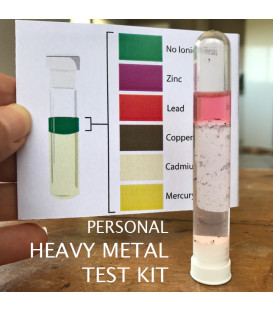
Your Exposure to Cadmium & Arsenic
Cadmium & Arsenic Exposure
Cadmium, in industry is a by-product from the extraction of zinc, lead and copper.
Cadmium is found in pesticides and manures therefore are seen to enter the environment from terra-forming.
Peoples exposure to cadmium is mainly through residual pesticides on the foods we eat and tobacco.
The cadmium in tobacco smoke enters the bloodstream via the respiratory system and distributed to the rest of the body.
Cadmium can severely damage the lungs and may even cause death.
Once the cadmium reaches the liver where it is bonded to protein forming complexes, which are then transported to the kidneys where accumulation causes damage to the filtration process.
This damage allows essential proteins and glycol nutrients to be excreted from the body causing even further kidney damage.
Cadmium in the home
Contamination by cadmium may occur as a result of impurities in the zinc of galvanized pipes or in solders used in fittings, water heaters, water coolers and taps.
Cadmium can also be released to the environment in waste water, through contamination of fertilizers, and by metallurgical industries.
Cadmium metal is used as an anti-corrosive coating on steel but its use is being phased out.
Cadmium compounds are commonly used as pigments in plastics, in batteries and in some electrical components.
It can be found in soils due to insecticides, fungicides, sludge, and commercial fertilizers that use cadmium in agriculture.
Food is the main source of cadmium intake.
The estimated average Australian adult dietary intake of cadmium is approximately 0.03 mg per day.
Smoking is a significant additional source of cadmium.
Cadmium absorption
Absorption of cadmium in the gastro-intestinal tract depends on a number of factors including the solubility of the compounds ingested, but a healthy person typically absorbs 3-7% of ingested cadmium.
This figure may be higher in people with iron, calcium and protein deficiency.
Cadmium accumulates in the kidney and is only released very slowly, with a biological half-life in humans of 10 to 15 years.
In humans, long-term exposure can cause kidney dysfunction leading to the excretion of protein in the urine.
This may occur, in a certain proportion of people, if the amount of cadmium exceeds 200 mg/kg renal cortex tissue; about 10% of the population is estimated to possess this sensitivity.
Other effects can include osteomalacia (softening of the bones).
Cases of Itai-Itai disease have been reported in Japan among elderly women exposed to highly contaminated food and water.
Symptoms are similar to osteomalacia accompanied by kidney dysfunction characteristic of cadmium poisoning.
Epidemiological studies have looked for a connection between lung cancer and work-place cadmium inhalation, but the results have been inconclusive.
The International Agency for Research on Cancer has concluded that cadmium is probably carcinogenic to humans.
Video on Cadmium Toxicity by Elena Pascual
Adverse Health Effects of Cadmium
- Damage to the central nervous system;
- Damage to the immune system;
- Fragile bones;
- Psychological disorders and possibly DNA damage or cancer development.
- Reproductive failure and possibly even infertility;
Arsenic exposure
Arsenic is a naturally occurring element which can be introduced into water through the dissolution of minerals and ores (where it exists mainly in the sulfide form), or from industrial effluent, atmospheric deposition (through burning of fossil fuels and waste incineration), drainage from old gold mines, or the use of some types of sheep dip.
Natural sources can make a significant contribution to the arsenic concentration in drinking water.
Pentavalent arsenic (As(V)) is generally the most common form in well oxygenated surface waters but under reducing conditions, such as those found in deep lake sediments or ground waters, the trivalent form (As(III)) predominates.
Although the results of studies indicate that arsenic may be essential for a number of animal species, there is no evidence that it is essential for humans.
Soluble arsenic salts are readily absorbed by the gastro-intestinal tract.
After absorption inorganic arsenic binds to haemoglobin, and is deposited in the liver, kidney, lungs, spleen, and skin. Inorganic arsenic does not appear to cross the blood-brain barrier but can cross the placenta.
Approximately 45 85% of ingested arsenic is excreted in the urine within 1 to 3 days.
Extensive reviews and summaries of the human and animal toxicity data for arsenic are available (IPCS, 1981; WHO 1988).
Download & More Details
![]() Your Exposure to Lead & Aluminium
Your Exposure to Lead & Aluminium
![]() Occupational Exposure to Heavy Metals
Occupational Exposure to Heavy Metals
Disclaimer: All information on this web site is for informational purposes only. Under no circumstance is any product on this site intended to diagnose, treat, cure or prevent any disease or condition. Please contact a medical doctor to diagnose and treat any medical condition.











